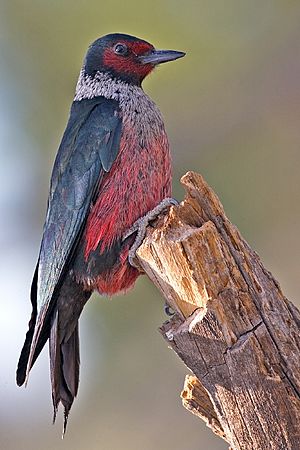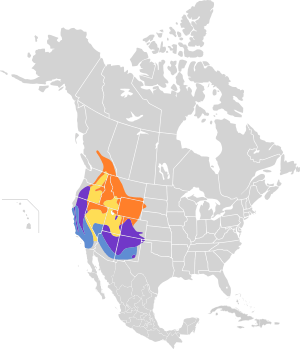Lewis's woodpecker facts for kids
Quick facts for kids Lewis's woodpecker |
|
|---|---|
 |
|
| Conservation status | |
| Scientific classification | |
| Genus: |
Melanerpes
|
| Species: |
lewis
|
 |
|
The Lewis's woodpecker (Melanerpes lewis) is a large woodpecker found in North America. This interesting bird was named after Meriwether Lewis. He was one of the famous explorers who surveyed new lands for the United States. Lewis discovered this woodpecker during his travels.
Contents
How Lewis's Woodpecker Got Its Name
The Lewis's woodpecker was first described in 1811. An American bird expert named Alexander Wilson wrote about it. He included it in his book, American Ornithology. Wilson learned about the bird from samples collected during the Lewis and Clark Expedition. This expedition explored the western United States between 1803 and 1806.
Wilson gave the bird its English name, "Lewis's woodpecker." He also gave it the scientific name Picus torquatus. However, this scientific name was already in use for another bird. So, in 1849, a zoologist named George Robert Gray gave it a new name: Picus lewis. Today, the Lewis's woodpecker is part of the genus Melanerpes.
What Does Lewis's Woodpecker Look Like?
Lewis's woodpecker is one of the biggest woodpeckers in America. It can grow to be about 26 to 28 centimeters (10 to 11 inches) long. Its body is mostly a blackish-green color. It has a reddish chest and a black back.
This woodpecker has a gray collar around its neck. Its upper chest is also gray. You might notice its pinkish belly and a bright red face. Its wings are wider than those of most other woodpeckers. It flies slowly, with steady wing beats. This makes it look a bit like a crow flying. Its calls sound a bit harsh compared to other woodpeckers.
Lewis's Woodpecker Measurements
- Length: 26-28 cm (10.2-11.0 in)
- Weight: 88-138 g (3.1-4.9 oz)
- Wingspan: 49-52 cm (19.3-20.5 in)
Where Do Lewis's Woodpeckers Live?
Lewis's woodpeckers are quite common in certain areas. They prefer to live in open pine forests. They also like other places with scattered trees and dead tree trunks. Unlike many other woodpeckers, they enjoy sitting out in the open. They don't hide much in thick tree cover.
These birds are mostly found in the western and central United States. In winter, they might fly south to the border with Mexico. In summer, they can travel north into Canada. They have even been seen in some Midwestern states. These include South Dakota, Michigan, Illinois, Minnesota, and Wisconsin.
How Lewis's Woodpeckers Find Food
Lewis's woodpeckers have some unique ways of finding food. They don't always act like typical woodpeckers. While they do drill into trees for insects, they also catch insects in the air. This is called "hawking." Only a few other woodpeckers, like the Acorn woodpecker and the red-headed woodpecker, do this.
These woodpeckers also eat berries and nuts. They are very clever with nuts! They will even crack them open and store them. They hide nuts in cracks and holes in wood. This way, they have food saved up for winter. You might also see them eating at bird feeders. They can be quite bossy towards other birds there.
Reproduction and Life Cycle
Lewis's woodpeckers build their nests inside holes. They usually make these holes in dead tree branches. The male woodpecker does most of the work to dig out the nest. The female then lays between 5 and 9 eggs. These eggs are plain white.
Both the male and female woodpeckers take turns keeping the eggs warm. The female sits on the nest during the day. The male takes over at night. The eggs hatch after about 12 days. The young birds stay in the nest for 4 to 5 weeks. After that, they are ready to leave and explore on their own.
See also
 In Spanish: Carpintero de Lewis para niños
In Spanish: Carpintero de Lewis para niños


